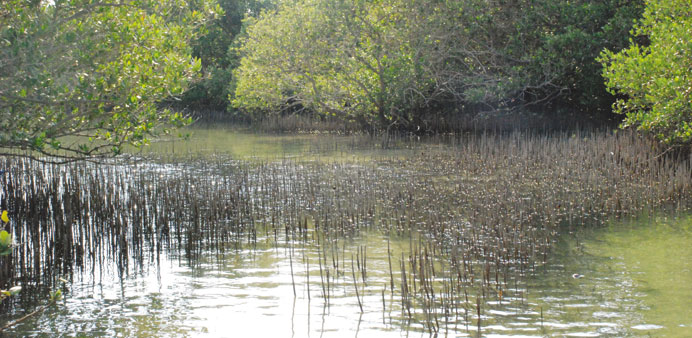Mangroves in eastern Qatar. PICTURE: Chanthy Huot, Unesco
By Bonnie James/Deputy News Editor
Qatar, the highest per capita carbon emitter in the world according to statistics from the United Nations, could initiate a process for carbon offsetting through floating mangroves, an innovative idea from Unesco Doha Office.
“Floating mangroves for carbon sequestration is an ideal contribution to Qatar’s legacy of hosting the United Nations Climate Change Conference late last year,” Unesco Arab Region’s ecological sciences adviser, Dr Benno Boer, told Gulf Times.
The proposal, which has not yet grasped the attention of the climate change movement, is to develop prototypes of floating mangroves and to measure their ecological capacity for carbon sequestration, uptake of marine pollutants and economic feasibility.
“Mangroves, salt marshes and sea grasses, which are major biological carbon sinks, store as much carbon as all plant biomass on land,” Boer explained.
Mangroves, which can store 50 times more carbon in comparison to tropical forests and 10 times more than temperate forests, absorb 1.5 tonnes of carbon per hectare per year apart from protecting against coastal erosion.
“If mangroves used to cover 32mn hectares globally, now only 15mn remains,” the Unesco expert pointed out while observing that there had been successful initiatives to increase localised mangrove coverage in Abu Dhabi and Eritrea.
Floating mangroves, proposed to be grown on floating platforms in the coastal areas, can also reduce land-based marine pollution by intake of potassium, nitrogen and phosphates and thereby possibly reduce harmful algal blooms.
“Timing is an important factor, because the plants flower in May/June and need time to germinate, for root anchorage, and growth,” Boer said.
The increase of biomass is a critical factor for the measurement of carbon sequestration. Therefore the project should initially run at least over a period of three years, with a prospect of renewal, and widening it into additional test-sites in the topics.
Considering that Qatar has an annual CO2 emission equivalent to 85,000,000 tonnes and one hectare of mangroves can take up 1.5 tonnes of CO2 per year, the assumption is that floating mangroves on 600,000sq km of ocean would be required.
Though as much as 360,000,000sq km of ocean surface is available globally, only a small percentage is suitable for the project due to temperature and nutrient availability.
w had recently highlighted the threat to Qatar’s mangrove and salt marsh ecosystems at Al Khor and Al Dhakeera, which are constantly littered with waste materials washed up from the sea.
“Mangroves in eastern Qatar need priority conservation and research,” the Unesco official asserted while suggesting urgent protection through an Emiri Decree.
“Awareness, management and conservation plans need to be developed, in order to generate the much needed attention with top level political support.
“Abu Dhabi deserves applause because it is very active in mangrove development since the 1970s, and is one of the few countries that actually show an increase in mangrove coverage,” he said.
Boer pointed out there were about nine to 10 sites of importance for mangrove conservation in Qatar and the ethno-botany, bio-geography, and conservation and development prospects needed documentation and awareness.
“Conservation and research are absolutely essential for their management,” he added.
Although per-capita carbon emissions have reduced by nearly 30% in Qatar since 2005, they still remain over 20% higher than the next closest per-capita emitter – Trinidad and Tobago – and over three times as high as per-capita emissions in the US, according to the Global Carbon Capture and Geological Storage (CCS) Institute.
But with some of the world’s largest CCS research initiatives, Qatar is fast becoming a leading proponent of CCS development. According to the Global CCS Institute, one reason Qatar has the world’s highest per-capita emissions is that it’s mostly desert, with almost zero rainfall. The country requires desalination plants to generate its water supply – a process which further intensifies the country’s demand for energy. Both water and electricity are also offered free to the nationals, which reduces any incentive to conserve.
Qatar is wholly dependent on oil and natural gas for its energy needs. The main source of greenhouse gas emissions is the energy sector, which accounts for 92% of all emissions. The rest comes mainly from the transport sector.
In September 2012, the Qatar Carbonates and Carbon Storage Research Centre (QCCSRC) was established as a $70mn, 10-year research partnership between Shell, Qatar Petroleum, Imperial College London and the Qatar Science and Technology Park. QCCSRC will help build Qatar’s capacity in CCS and cleaner fossil fuels, involving over 40 academic staff, post-doctoral researchers and PhD students.
In October 2012, Qatar University’s Gas Processing Centre announced the release of a Carbon Capture and Management Road Map.
In March, 2012, the Qatar Fuel Additives Company (Qafac) placed an order for a large-scale CO2 recovery plant from Mitsubishi Heavy Industries. The proposed plant is to be installed within Qafac’s methanol production plant by autumn 2014, the Global CCS Institute has added.



